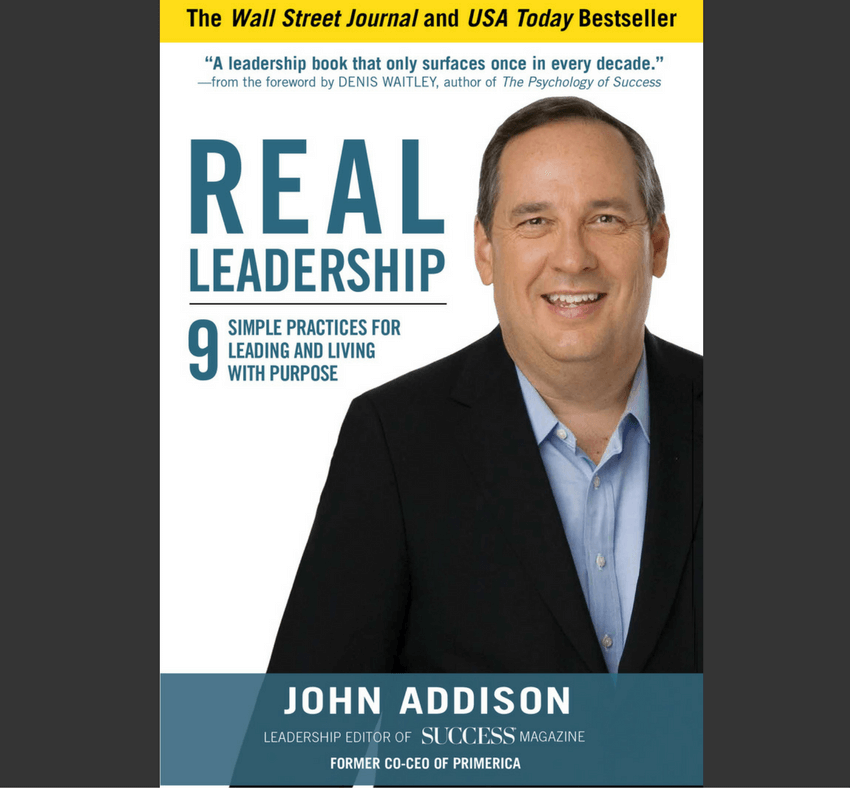


Key employee leaving? Team conflict? Not making your numbers? Tight client deadline? New competitor entering the market? Family conflict? Health challenges? Few leaders are strangers to stress. Some succumb to a heart attack or stroke. Others simply endure in silence. Only a few feel rock-solid serene through it all.
From the very opening pages of John Addison’s book Real Leadership: 9 Simple Practices for Leading and Living With Purpose, I got the sense that this man feels at peace with the world. Although he writes of challenges in climbing the proverbial ladder to become co-CEO of a billion-dollar division of the world’s largest company and piloting his team through The Great Recession, evidence points to the fact that he remained calm in the eye of the storm.
How?
That’s what I wanted to know as I delved into the nine practices outlined in Addison’s book. Practice #6 held the secret: Develop a peaceful core. He offers four suggestions to put this practice into daily use:
Tend the Garden of Your Mind
Golf is not my idea of recreation. I’d much rather spend the day digging in the dirt, planting trees, working on my garden. Even at the most hectic times in my career, I’d spend all weekend every chance I got messing around on my little farm. It’s the one thing I can do where I’m not worried about anything else or even thinking about anything else.
Churchill was an accomplished painter who produced more than 500 works. He wrote in his book Painting as a Pastime, “If it weren’t for painting, I could not live, I could not bear the strain of things.”
Whether you golf, garden, or paint to develop a peaceful core, it’s that core that generates the power to deal with all the things leadership entails.
But anyone who’s ever grown a garden knows this: It’s a lot easier to grow weeds than plants. Your mind works the same way. Left on their own, negative thoughts will sprout up and strangle positive thoughts you have planted there. If you want to succeed, constantly tend to what’s growing in your brain. You have to till and weed your brain every day. And that’s not something you can do by repeating a few affirmations taped to your bathroom mirror as you dash out the door every morning.
As with field weeds, it’s a lot tougher to dig out brain weeds once their roots get deep. You can’t just snap negative thoughts off at the surface; they grow back quickly. You have to pull out all the self-doubt, criticism, and frustration every day before the roots grow deeper and deeper. The deeper the roots grow, the harder negativity is to defeat in your outlook, your approach, and your organizational culture.
Don’t Let Yourself React to Problems With Panic or Anxiety
Without a peaceful core, you tend to panic when problems arise. But most often, the “problem” or “crisis” is not a problem at all; it’s simply a situation. If you can “make an adjustment” to alter the outcome, then you’re facing only a situation, not a true problem. If nothing can alter the situation, then you have a true problem.
The answer to both challenging situations and problems? Focus on possibilities—what you can control.
Be Quick to Forgive and Even Quicker to Apologize
Grudges only get worse with time. You can’t go through life carrying every wrong done to you in your backpack. If you try to, you’ll never get to the top of the mountain or the end of the trail. Let go of the garbage that’s weighing you down and move on. Nothing ever comes from bitterness, except defeat and more unhappiness.
Be Conscious of How Much Negativity You’re Letting Into Your Brain
Protect your peaceful core. Certainly, you want to be informed. But manage your exposure to all the negative input every day—from TV, radio, internet news, gossip, and complainers around you.
Live every day as if it’s your last. One day, you’re going to be right. Every day, aim to be down-deep serene.
John Addison is the Leadership Editor for SUCCESS magazine and the author of Real Leadership: 9 Simple Practices for Leading and Living with Purpose, a Wall Street Journal and USA Today best-seller. Renowned for his insight and wisdom on leadership, personal development and success, John is a sought-after speaker and motivator. Read more on his blog, and follow John on Facebook and Twitter.